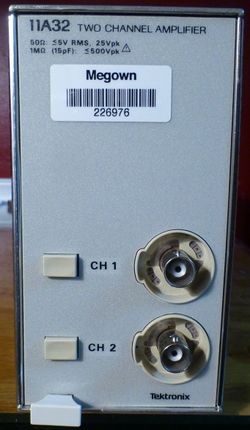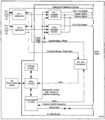11A32: Difference between revisions
No edit summary |
No edit summary |
||
| Line 32: | Line 32: | ||
==Internals== | ==Internals== | ||
===Analog=== | ===Analog=== | ||
Each input channel has a separate attenuator module containing an [[M474]] buffer amplifier. | Each input channel has a separate attenuator module containing passive 1 megohm attenuators, an AC coupling capacitor, a switch selecting the calibrator or signal input, and an [[M474]] buffer amplifier. The calibrator signal turned off inside the plugin when not in use. | ||
The | |||
The | The attenuator module output feeds the + input of the [[M377]] amplifier IC through a (blue) 50 ohm transmission line, one per input channel. The cable lengths set a standard delay per plugin. | ||
50 | |||
When not enabled, each M377 differential output is exactly zero by design. | The M377's - input is connected to the [[ACVS]] (Analog Control Voltage System) output. | ||
This fact is used during calibration by the plugin’s firmware to determine the mainframe’s imbalance and compensate for it during normal operation. | |||
The (differential) display outputs of the two amplifiers are hard-wired in parallel and drive the mainframe’s | |||
50 Ω per side input impedance. The same is true of the trigger outputs of the two amplifiers. | |||
The version of the M377 used in the 11A32 has a 100 Ω output impedance per side so that two of them in parallel | |||
create a source impedance of 50 Ω. | |||
Each M377 amplifier's nominal common-mode output voltage is zero whether enabled or not. When not enabled, each M377 | |||
differential output is exactly zero by design. This fact is used during calibration by the plugin’s firmware to | |||
determine the mainframe’s imbalance and compensate for it during normal operation. | |||
Each of the two channels has its own AUX output on dedicated pins of the plug-in interface connector: | |||
See also the block diagram below. | See also the block diagram below. | ||
Revision as of 21:33, 31 December 2022
The Tektronix 11A32 is a 400 MHz dual-channel amplifier plug-in for 11000-series scopes.
Key Specifications
| Bandwidth | DC to 400 MHz. 100 MHz and 20 MHz four pole BWL (Bandwidth Limit) filters may be selected. |
|---|---|
| Rise time | 875 ps in 1 GHz mainframes such as the 11402, 11402A, 11403, 11403A, DSA601A, or DSA602A |
| Deflection | 1 mV to 10 V per division in 1% calibrated steps |
| Input impedance | 50 Ω or 1 MΩ |
| Features |
|
Internals
Analog
Each input channel has a separate attenuator module containing passive 1 megohm attenuators, an AC coupling capacitor, a switch selecting the calibrator or signal input, and an M474 buffer amplifier. The calibrator signal turned off inside the plugin when not in use.
The attenuator module output feeds the + input of the M377 amplifier IC through a (blue) 50 ohm transmission line, one per input channel. The cable lengths set a standard delay per plugin.
The M377's - input is connected to the ACVS (Analog Control Voltage System) output.
The (differential) display outputs of the two amplifiers are hard-wired in parallel and drive the mainframe’s
50 Ω per side input impedance. The same is true of the trigger outputs of the two amplifiers.
The version of the M377 used in the 11A32 has a 100 Ω output impedance per side so that two of them in parallel
create a source impedance of 50 Ω.
Each M377 amplifier's nominal common-mode output voltage is zero whether enabled or not. When not enabled, each M377
differential output is exactly zero by design. This fact is used during calibration by the plugin’s firmware to
determine the mainframe’s imbalance and compensate for it during normal operation.
Each of the two channels has its own AUX output on dedicated pins of the plug-in interface connector:
See also the block diagram below.
Digital
The 11A32 and the 11A34 use exactly the same firmware.
The 11A32 and 11A34 were originally intended to use Intel 8052 microcontrollers. However, during development, the firmware swelled beyond that chip's 8192-byte maximum on-chip ROM size. Doug Haines found an alternate supplier of 8051-compatible chips (OKI Semiconductor) that offered a 16Kbyte on-chip ROM, and that's what the plug-ins wound up with. The finished code size wound up at about 14 KB.
The 11A32 also contains a DS1120 NVRAM and an ACVS module that generates the analog control voltages needed for gain/offset control etc.
Links
Pictures
-
-
-
Block diagram
-
11A32 Main Board Schematic
-
11A32 Main Interface
-
left side internal
-
right side internal
Custom ICs used in the 11A32
| Page | Model | Part nos | Description | Designers | Used in |
|---|---|---|---|---|---|
| M377 | M377 | 165-2129-03 • 165-2089-06 • 155-2089-05 | amplifier | John Addis | 11A16 • 11A32 • 11A33 • 11A34 • 11A52 • 2245 • 2245A • 2247 • 2247A • 2252 • TDS410 • TDS420 • TDS460 • TDS520D • TDS540D • TDS580D • TDS680C • TDS684C • TDS714L • TDS724D • TDS754D • TDS784D |
| M474 | M474 | amplifier | John Addis • Ivan John Cousins | 11A32 • 11A34 |





